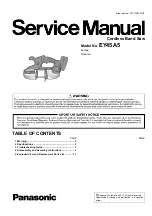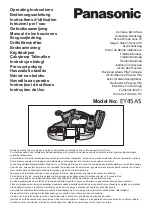
English
5
•
Don’t expose power tools to rain or wet conditions.
Water
entering a power tool will increase the risk of electric shock.
•
Do not abuse the cord.
Never use the cord to carry the tools
or pull the plug from an outlet. Keep cord away from heat, oil,
sharp edges or moving parts. Replace damaged cords immedi-
ately. Damaged cords increase the risk of electric shock.
•
When operating a power tool outside, use an outdoor
extension cord marked “W-A” or “W.”
These cords are rated
for outdoor use and reduce the risk of electric shock. When
using an extension cord, be sure to use one heavy enough to
carry the current your product will draw. An undersized cord will
cause a drop in line voltage resulting in loss of power and over-
heating. The following table shows the correct size to use
depending on cord length and nameplate ampere rating. If in
doubt, use the next heavier gage. The smaller the gage number,
the heavier the cord.
Recommended Minimum Wire Size for Extension Cords
Total Length of Cord
25 ft.
50 ft.
75 ft.
100 ft.
125 ft.
150 ft.
175 ft.
7.6 m
15.2 m
22.9 m 30.5 m
38.1 m 45.7 m 53.3 m
Wire Size AWG
18 18
16
16
14
14
12
•
Avoid accidental starting.
Be sure switch is off before plugging
in. Carrying tools with your finger on the switch or plugging in
tools that have the switch on invites accidents.
•
Disconnect the plug from the power source before making
any adjustments, changing accessories, or storing the tool.
Such preventative safety measures reduce the risk of starting
the tool accidentally.
• The label on your tool may include the following symbols.
V......................volts
A ..............amperes
Hz....................hertz
W ............watts
min ..................minutes
............alternating current
....................alternating or
........direct current
........................
direct current
no ............no load speed
....................Class II
…/min ......revolutions per
........................
Construction
..................
minute
....................
earthing terminal
............safety alert symbol
Important Safety Instructions for
Battery Packs
Your tool uses a 24 Volt D
E
WALT battery pack. When ordering
replacement battery packs, be sure to include catalog number and
voltage: Extended Run-Time battery packs deliver more run-time
than standard battery packs. Consult the chart at the end of this
manual for compatibility of chargers and battery packs.
NOTE:
Your tool will accept either standard or Extended Run Time
battery packs. However, be sure to select proper voltage. Batteries
slowly lose their charge when they are not on the charger, the best
place to keep your battery is on the charger at all times.
The battery pack is not fully charged out of the carton. Before using
the battery pack and charger, read the safety instructions below.
Then follow charging procedures outlined.
READ ALL INSTRUCTIONS
•
Do not incinerate the battery pack even if it is severely dam-
aged or is completely worn out.
The battery pack can explode
in a fire.
•
A small leakage of liquid from the battery pack cells may
occur under extreme usage or temperature conditions.
This
does not indicate a failure. However, if the outer seal is broken
and this leakage gets on your skin:
a. Wash quickly with soap and water.
b. Neutralize with a mild acid such as lemon juice or vinegar.







































